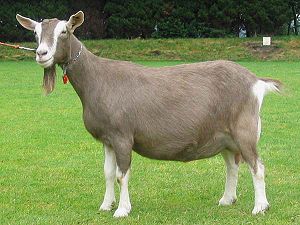Difference between revisions of "Translations:AY Honors/Livestock/Answer Key/14/en"
(Importing a new version from external source) |
(Importing a new version from external source) |
||
| Line 1: | Line 1: | ||
| − | {{: | + | {{:AY Honors/Goat Breeds/Toggenburg}} |
Latest revision as of 17:21, 8 September 2021
Toggenburg
The Toggenburg is named after the region in Switzerland where the breed originated, the Toggenburg valley. Toggenburgs are medium in size, moderate in production, and have relatively low butterfat content (2-3%) in their milk. The color is solid varying from light fawn to dark chocolate with no preference for any shade. Distinct white markings are as follows: white ears with dark spot in middle; two white stripes down the face from above each eye to the muzzle; hind legs white from hocks to hooves; forelegs white from knees downward with a dark line (band) below knee acceptable; a white triangle on either side of the tail. Wattles, small rudimentary nubs of skin located on each side of the neck, are often present in this breed. The Toggenburg underwent a development program when introduced to Britain - the resulting British Toggenburg being heavier and having improved milk quality. By the middle of the year 2002, 4146 Toggenburgs had been registered with the New Zealand Dairy Goat Breeders Association, representing 8.10% of registered dairy goats. They perform better in cooler conditions. They are the oldest known dairy breed of goats.

